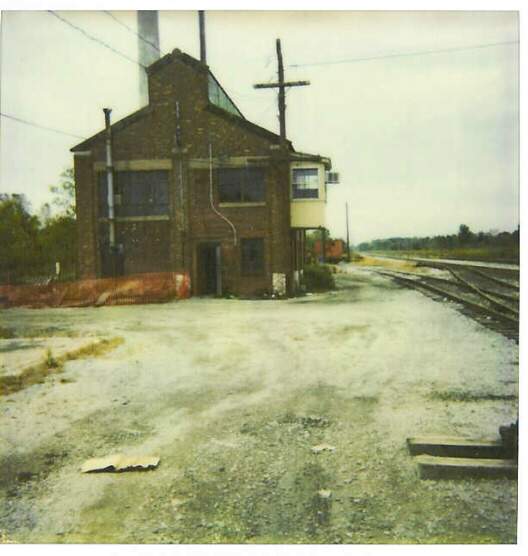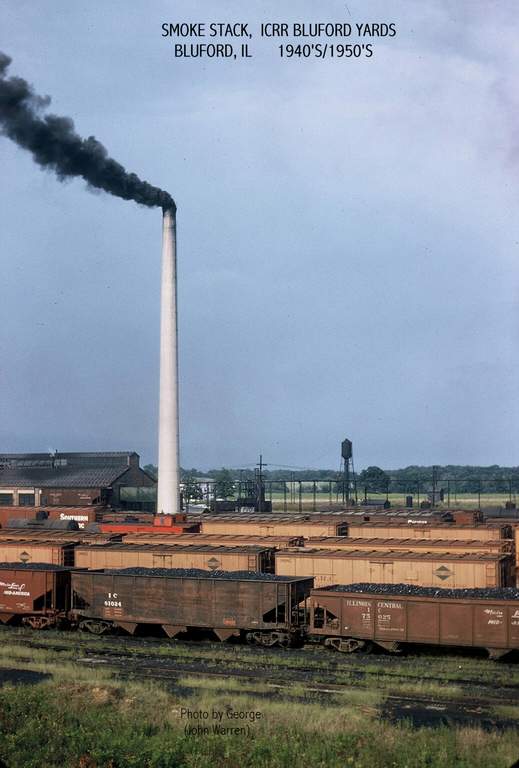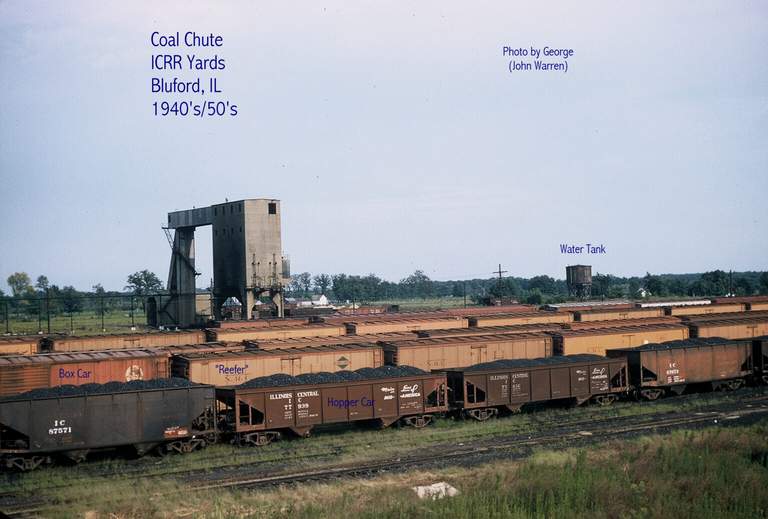
KIDS, RAILROADS, PEOPLE & ACTIVITIES
STORIES OF A SMALL RAILROAD TOWN
IN THE 1930'S, 40'S & 50'S ........... by George
John R. Warren
The articles and pictures that you see within these pages about Bluford
were submitted by Janice Staples
Written permission was given by the author, the late John R. Warren, to use on this website.


|
 The Yard Office |
| The Yard Office was a two-story building located near to the yard tracks, just east of the Thoroughfare. The downstairs was a washroom for switchmen and roadmen and contained showers, lockers, benches and tables. The offices of the yard office were all upstairs. |
 Smokestack |
| The smokestack was an impressive 195 feet tall. It was built of concrete and brick and was located 21 feet south of the boiler room. The ladder on the south side of the stack extended all the way to the top. Each rung on the ladder was 12" from the next rung. Lightning rods were located atop the stack. The stack was designed to sway some with the wind. There were reports from time to time of people climbing the smokestack, the tallest structure around Bluford. |
 Coal Chute |
| The coal chute was located to the east and south of the other buildings. Coal would be unloaded from hopper cars to the east of the chute. Several hopper cars could be held on an incline track, and then individually rolled down the track by gravity to the coal dumping area. After the coal was dumped into the holding area, it was taken to the top of the coal chute by a chained bucket system and dropped into the top of the chute. The coal could then be dropped into the engines' "tenders" to load them up for road trips. |

|
|
Bluford had at least 2 depot buildings. The first was a classic old style, small town depot. It had a freight room, the station agent's office in the middle, with a bay window so he could see down the tracks, and a passenger waiting room. The Southern RR had 2 passenger trains that had regular stops in Bluford. A "Noon Train" and an "afternoon train" The noon train went east and arrived between 11:30 and noon. The afternoon train went west about 3:30 p.m. Buildings not pictured: The Round House: The "Round House" was actually a complex of three systems that included a building, in a quarter round configuration, where the repair and servicing of steam engines was done; a circular pit housing the turntable, where engines could be turned to face any direction; and twelve sets of tracks used for parking the engines. The building was shaped like a quarter of a pie, and at the pointed end of that quarter pie was the turntable. It was 237 feet from the ceneter of the turntable and the start of the roundhouse building. Machine Shop & Boiler Room: The Machine Shop was the next building east of the Yard Office. It was 42' wide and 148.5' long. The boiler room was in the south 68' of the building and the machine shop in the north 80'. The floor of the machine shop had a unique pattern of wood pieces placed on edge. The wood blocks were about 3" high, 3 3/4" wide, and 6 to 8" long. The boiler room contained 3 "huge" boilers, which faced west toward the 3 coal bins. The boilers were connected to the 195' smokestack by a metal flu. Steam was produced to run air compressors, and to provide hot water & steam for cleaning and maintenance equipment Mechanical Dept. Wash Room: This was located about 50' north of the Yard Office. There was a fire hose building north of it. Repair Track Complex: The Repair Track "Rip Track" was seperate from the other yard buildings and was somewhat of an independent operation of it's own, not directly concerned with the operatins going on in the yard. Shanties: There was a car knocker shanty south of the yard office and west of the tracks that went to the coal bin ramp of the boiler room. It was about 12'X40'. The section crews also had pads to park their motor cars there. Along the north end and south end switching leads were the switchmen's or checker's shanties. The yard clerks stayed in those and kept track of the cars, as they were moved from track to track. The shanties had a water cooler, a heating stove, and benches. The switchmen could get a bit of rest there when the trains were pulling in or out, and had the switching lead blocked. |
For corrections or additions, please contact me: Sandy Bauer